If you've been affected by the recent flooding on the Coromandel or in the Bay of Plenty, you might be eligible to make a claim for loss or damage to your home through the Earthquake Commission.
Anyone who has been affected has up to three months from the date of the flooding to lodge a claim with the EQC.
In order to lodge a claim with the EQC, you must have a home or contents fire insurance policy with a private insurance company at the time the natural disaster damage occurred.
Customers with home insurance will also receive EQC cover for certain land damage – but what EQC covers depends on how the damage occurred.
For storms and floods, EQC covers damage to residential land only, within certain limits, while private insurers cover house and contents damage, according to the terms of an individual's policy.
While for natural landslip damage, EQC covers damage to home, contents and land, within certain limits.
WHAT IS COVERED?
EQC's coverage of land is limited to land which falls within your property boundary.
This includes land under your home and outbuildings, like sheds or garages, land within eight metres of your home and outbuildings, and land under or supporting your main access way, up to 60 metres from your home - but not the driveway surfacing.
Furthermore, EQC also provides some cover for bridges and culverts within the above areas, and some retaining walls that are necessary to support the home, outbuildings or insured land.
For landslip damage, your building is generally insured by EQC up to a maximum of $100,000 +GST and is covered on a replacement value basis.
WHAT IS NOT COVERED?
However, EQC doesn't cover certain items on the land like trees, plants, lawns and driveways, but does cover the removal of debris from your insured land, such as fallen trees.
EQC land cover is usually capped at the dollar value of the area of insured land that has been lost or damaged (or will imminently be) as a direct result of the natural disaster.
Where the area of damage is large enough, that value will instead be calculated using whichever of these is the smaller - the minimum allowable lot size under the council's district plan; or an area of 4000 square metres.
It is also important to note that bridges, culverts, and retaining walls that support the home or insured land are covered for indemnity value. This means the valuation takes into account their age and state of repair.
For more information and other EQC guides, visit www.eqc.govt.nz



0 comments
Leave a Comment
You must be logged in to make a comment.